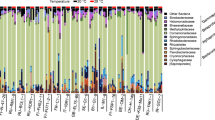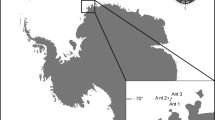Abstract
Environmental stress imposes strong natural selection on clonal populations, promoting evolutionary change in clonal structure. Environmental stress may also lead to reduction in population size, which together with clonal selection may reduce genotypic diversity of the local populations. We examined how clonal structure in wild-collected samples of two parthenogenetic populations of the freshwater ostracod Eucypris virens responded to hypersalinity and starvation, and the combination of the two stressors. We applied the stress treatments in a factorial design for one generation. When 60% of the individuals per experimental unit had died, post-experimental clonal structure was compared to that of the start of the experiment, which reflected the field conditions. We used five polymorphic allozyme loci as genotype markers. All stress treatments reduced survival compared to the control treatment. In the population “Rivalazzetto”, we observed a reduction of clonal richness in the control treatment, with the initially dominant clone maintaining dominance. This may have resulted from interclonal competition and clone-specific survival under the different laboratory conditions. Clonal richness remained high in the salinity treatment while it was reduced in the combined stress and starvation treatments. In the population “Fornovo”, clonal richness reduced in all treatments including control, while the salinity and combined stress treatment reduced clonal evenness. The clone dominating at the start of the experiment increased in frequency in all treatments, but the change in clonal structure during the experiment was more pronounced in this population. These results suggest that in some conditions an intermediate level of environmental stress may lessen the decline in genetic diversity by strong inter-clonal competition. Moreover, the variation in clonal structure among the stress treatments and distinct genetic backgrounds indicates that more general predictions of stress effects on clonal structure may be difficult.



Similar content being viewed by others

References
Adolfsson S, Michalakis Y, Paczesniak D, Bode SNS, Butlin RK, Lamatsch DK, Martins MJF, Schmit O, Vandekerkhove J, Jokela J (in press) Evaluation of elevated ploidy and asexual reproduction as alternative explanations for geographic parthenogenesis in Eucypris virens ostracods. Evolution. doi:10.1111/j.1558-5646.2009.00872.x
Ayre DJ (1995) Localized adaptation of sea anemone clones: evidence from transplantation over two spatial scales. J Anim Ecol 64:186–196
Baltanás A (1994) Taxonomy and ecology of Eucypris virens (Ostracoda, Cyprididae). In: Horne DJ, Martens K (eds) The evolutionary ecology of reproductive modes in nonmarine Ostracoda. Greenwich University Press, Greenwich, pp 9–16
Barclay MH (1966) An ecological study of a temporary pond near Auckland, New Zealand. Aust J Mar Freshwt Res 17:239–258
Bode S, Adolfsson S, Lamatsch D, Martins MJF, Schmit O, Vandekerkhove J, Mezquita F, Namiotko T, Rossetti G, Schön I, Butlin R, Martens K (in press) Exceptional cryptic diversity and multiple origins of parthenogenesis in a freshwater ostracod. Mol Phylogenet Evol doi: 10.1016/j.ympev.2009.08.022
Carvalho GR (1987) The clonal ecology of Daphnia magna (Crustacea: Cladocera). II. Thermal differentiation among seasonal clones. J Anim Ecol 56:469–478
Connell JH (1975) Some mechanisms producing structure in natural communities; a model and evidence from field experiments. In: Cody ML, Diamond JM (eds) Ecology and evolution of communities. Belknap Press, Cambridge, pp 460–490
Connell JH (1985) The consequences of variation in initial settlement vs. post-settlement mortality in rocky intertidal communities. J Exp Mar Biol Ecol 93:11–45
Delorme LD, Donald D (1969) Torpidity of freshwater ostracodes. Can J Zool 47:997–999
Dvornyk V, Nevo E (2003) Genetic polymorphism of cyanobateria under permanent natural stress: a lesson from the “Evolution Canyons”. Res Microbiol 154:79–84
Ellner S, Hairston NG Jr (1994) Role of overlapping generations in maintaining genetic variation in a fluctuating environment. Am Nat 143:403–417
Etterson JR (2004) Evolutionary potential of Chamaecrista fasciculata in relation to climate change. I. Clinal patterns of selection along an environment gradient in the Great Plains. Evolution 58:1446–1458
Forbes VE, Sibly RM, Calow P (2001) Toxicant impacts on density-limited populations: a critical review of theory, practice, and results. Ecol Appl 11:1249–1257
Gause GF (1934) The struggle for existence, 1st edn. Williams & Wilkins, Baltimore
Gui Y, Grant A (2008) Joint effects of density dependence and toxicant exposure on Drosophila melanogaster populations. Ecotox Environ Safe 70:36–243
Gyllström M, Hansson L-A (2004) Dormancy in freshwater zooplankton: induction, termination and the importance of benthic-pelagic coupling. Aquat Sci 66:274–295
Hedrick PW (1986) Genetic polymorphism in heterogeneous environments: a decade later. Ann Rev Ecol Syst 17:535–560
Hedrick PW (1995) Genetic polymorphism in a temporally varying environment: effects of delayed germination or diapause. Heredity 75:164–170
Hoffmann AA, Daborn PJ (2007) Towards genetic markers in animal populations as biomonitors for human-induced environmental change. Ecol Lett 10:63–76
Hoffmann AA, Parsons P (1997) Extreme environmental change and evolution. Cambridge University Press, Cambridge
Jokela J, Lively CM, Dybdahl MF et al (2003) Genetic variation in sexual and clonal lineages of a freshwater snail. Biol J Linn Soc 79:165–181
Kinnison MT, Hendry AP (2001) The pace of modern life. II. From rates of contemporary microevolution to pattern and process. Genetica 112–113:145–164
Kis-Papo T, Kirzhner V, Wasser SP et al (2003) Evolution of genomic diversity and sex at extreme environments: Fungal life under hypersaline Dead Sea stress. PNAS 100:14970–14975
Ludwig JA, Reynolds JF (1988) Statistical ecology: a primer on methods and computing. Wiley, New York
Lynch M (1987) The consequences of fluctuating selection for isozyme polymorphisms in Daphnia. Genetics 115:657–669
Martins MJF, Vandekerkhove J, Namiotko T (2008) Environmental stability and the distribution of the sexes: insights from life history experiments with the geographic parthenogen Eucypris virens (Crustacea: Ostracoda). Oikos 117:829–836
Meisch C (2000) Freshwater Ostracoda of western and central Europe. Spektrum Akademischer Verlag, Heidelberg
Mezquita F, Roca JR, Wansard G (1999) Moulting, surviving and calcification: the effects of temperature and water chemistry on an ostracod crustacean (Herpetocypris intermedia) under experimental conditions. Arch Hydrobiol 146:219–238
Moe SJ, Stenseth NC, Smith RH (2002) Density-dependent compensation in blowfly populations give indirectly positive effects of a toxicant. Ecology 83:1597–1603
Nevo E (2001) Evolution of genome-phenome diversity under environmental stress. PNAS 98:6233–6240
Otero M (1998) Ecología clonal de Eucypris virens (Jurine, 1820) (Crustacea, Ostracoda). Memoria de Licenciatura, Universidad Autónoma de Madrid, Facultad de Ciencias
Otero M, Rossi V, Baltanás A et al (1998) Effects of genotype and photoperiod on diapause strategies in Eucypris virens (Jurine, 1820) (Crustacea: Ostracoda). Arch Hydrobiol Spec Iss Adv Limnol 52:229–236
Parsons PA (1996a) Competition versus abiotic factors in variably stressfull environments: evolutionary implications. Oikos 75:129–132
Parsons PA (1996b) Stress, resources, energy balances, and evolutionary change. Evol Biol 29:39–72
Peleg Z, Saranga Y, Krugman T et al (2008) Allelic diversity associated with aridity gradient in wild emmer wheat population. Plant Cell Environ 31:39–49
Reznick DN, Ghalambor CK (2001) The population ecology of contemporary adaptations: what empirical studies reveal about conditions that promote adaptive evolution. Genetica 112–113:183–198
Rossi V, Menozzi P (1990) The clonal ecology of Heterocypris incongruens (Ostracoda). Oikos 57:388–398
Rossi V, Gandolfi A, Menozzi P (1996) Egg diapause and clonal structure in parthenogenetic populations of Heterocypris incongruens (Ostracoda). Hydrobiologia 320:45–54
Rossi V, Schön I, Butlin RK (1998) Clonal genetic diversity. In: Martens K et al (eds) Sex and parthenogenesis. Evolutionary ecology of reproductive modes in non-marine ostracods. Backhuys Publishers, Leiden, pp 257–274
Schmit O, Rossetti G, Vandekerkhove J et al (2007) Food selection in Eucypris virens (Crustacea: Ostracoda) under experimental conditions. Hydrobiologia 585:135–140
Schön I, Gandolfi A, di Masso E et al (2000) Persistence of asexuality through mixed reproduction in Eucypris virens (Crustacea, Ostracoda). Heredity 84:161–169
Semenova LM (2005) Fauna and distribution of the Ostracoda (Crustacea, Ostracoda) of inland waterbodies of Russia and contiguous states. Inland Water Biol 3:17–26
StatSoft Inc (2007) Electronic statistics textbook. StatSoft, Tulsa (http://www.statsoft.com/textbook/stathome.html)
Stoddard JA, Taylor JF (1988) Genotypic diversity: estimation and prediction in samples. Genetics 118:705–711
Vrijenhoek RC (1978) Coexistence of clones in a heterogeneous environment. Science 199:549–552
Vrijenhoek RC (1979) Factors affecting clonal diversity and coexistence. Am Zool 19:787–797
Weeks AR, Hoffmann AA (1998) Intense selection of mite clones in a heterogeneous environment. Evolution 52:1325–1333
Acknowledgments
This work was funded by the EU Marie Curie Research Training Network SexAsex (From Sex to Asex: a case study on interactions between sexual and asexual reproduction, contract MRTN-CT-2004-512492). We are very grateful to all members of the network for their practical contributions to the work presented here and for many stimulating discussions. J.J. acknowledges funding from the Swiss National Science Foundation and the Centre of Excellence in Evolutionary Research (Academy of Finland, University of Jyväskylä). Experiments reported in this work comply with the current laws of the Italian Republic.
Author information
Authors and Affiliations
Corresponding author
Electronic supplementary material
Below is the link to the electronic supplementary material.
Rights and permissions
About this article
Cite this article
Martins, M.J.F., Vandekerkhove, J., Adolfsson, S. et al. Effect of environmental stress on clonal structure of Eucypris virens (Crustacea, Ostracoda). Evol Ecol 24, 911–922 (2010). https://doi.org/10.1007/s10682-009-9349-6
Received:
Accepted:
Published:
Issue Date:
DOI: https://doi.org/10.1007/s10682-009-9349-6



